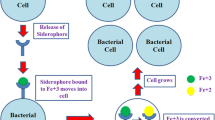Abstract
Cr(VI) tolerance was studied in four strains of Rhodosporidium toruloides and compared with that of a fifth strain, DBVPG 6662, isolated from metallurgical wastes and known to be Cr(VI) resistant. Tolerance was studied in relation to different species of sulfur (sulfates, thiosulfates, methionine, cysteine) at different concentrations. Djenkolic acid, a poor source of sulfur and an activator of sulfate transport, was also considered. In synthetic medium all strains except the Cr(VI)-resistant one started to be inhibited by 10 μg ml− (0.2 mm) Cr(VI) as K2Cr2O7. DBVPG 6662 was inhibited by 100 μg ml− (2.0 mm) Cr(VI). In Yeast Nitrogen Base without amino acids (minimal medium), supplemented with varying concentrations of chromate, all Cr(VI)-sensitive strains accumulated concentrations of total chromium (from 0.8 to 1.0 μg mg− cell dry wt) after 18 h of incubation at 28 °C. In minimal medium supplemented with 10 μg ml− Cr(VI), the addition of sulfate did not significantly improve the yeast growth. Cysteine at μm levels increased tolerance up to 10 μg ml−, whereas methionine only reduced the Cr(VI) toxicity in the strain DBVPG 6739. Additions of djenkolic acid resulted in increased Cr(VI) sensitivity in all strains. The best inorganic sulfur species for conferring high tolerance was thiosulfate at concentrations up to 1 mm. In all cases increased Cr(VI) tolerance was due to a significantly reduced uptake in the oxyanion by the cells and not to the chemical reduction of Cr(VI) to Cr(III) by sulfur compounds.
Similar content being viewed by others
References
Baldi F, Vaughan Martini AM, Olson GJ. 1990 Chromium(VI)-resistant yeast isolated from a sewage treatment plant receiving tannery wastes. Appl Environ Microbiol 56, 913–918.
Benitez JA, Alonso A, Delgado J, Kotyk A. 1983 Sulphate transport in Candida utilis. Folia Microbiol 28, 6–11.
Cervantes C, Ohtake H. 1988 Plasmid-determined resistance to chromate in Pseudomonas aeruginosa. FEMS Microbiol Lett 56, 173–176.
De Flora S, Wetterhahn KE. 1989 Mechanisms of chromium metabolism and genotoxicity. Life Chem Rep 7, 169–244.
Dubey SK, Rai LC. 1989 Toxicity of chromium and tin to Anabaena doliolum. Biol Metals 2, 55–60.
Efstathiou JD, McKay LL. 1977 Inorganic salts resistance associated with a lactose-fermenting plasmid in Streptococcus lactis. J Bacteriol 130, 257–265.
Hryniewicz M, Sirko A, Palucha A, Bock A, Hulanicka D. 1990 Sulfate and thiosulfate transport in Escherichia coli K-12: identification of a gene encoding a novel protein involved in thiosulfate binding. J Bacteriol 172, 3358–3366.
Ishibashi Y, Cervantes C, Silver S. 1990 Chromium reduction in Pseudomonas putida. Appl Environ Microbiol 56, 2268–2270.
Marzluf GA. 1970 Genetic and metabolic controls for sulfate metabolism in Neurospora crassa: isolation and study of chromate-resistant and sulfate transport-negative mutants. J Bacteriol 102, 716–721.
Metzenberg RL, Parson JW. 1966 Altered repression of some enzymes of sulfur utilization in a temperature-conditional lethal mutant of Neurospora. Proc Natl Acad Sci USA 55, 629–635.
Nies A, Nies DH, Silver S. 1989 Cloning and expression of plasmid genes encoding resistances to chromate and cobalt in Alcaligenes eutrophus. J Bacteriol 171, 5065–5070.
Ohtake H, Cervantes C, Silver S. 1987 Decreased chromate uptake in Pseudomonas fluorescens carrying a chromate resistance plasmid. J Bacteriol 169, 3853–3856.
Pepi M, Baldi F. 1992 Modulation of chromium(VI) toxicity by organic and inorganic sulfur species in yeasts from industrial wastes. BioMetals 5, 179–185.
Silver S, Walderhaug M. 1992 Gene regulation of plasmid and chromosome-determined inorganic ion transport in bacteria. Microbiol Rev 56, 195–228.
Sirko A, Hryniewcz M, Hulanicka D, Bock A. 1990 Sulfate and thiosulfate transport in Escherichia coli K-12: nucleotide sequence and expression of the cysTWAM gene cluster. J Bacteriol 172, 3351–3357.
Summers AO, Jacoby GA. 1978 Plasmid-determined resistance to boron and chromium compounds in Pseudomonas aeruginosa. Antimicrob Agents Chemother 13, 637–640.
Suzuki T, Miyata N, Horitzu H et al. 1992 NAD(P)H-dependent chromium(VI) reductase of Pseudomonas ambigua G-1: a Cr(VI) intermediate is formed during the reduction of Cr(VI) to Cr(III). J Bacteriol 16, 5340–5345.
Wang P, Mori T, Komori K et al. 1989 Isolation and characterization of an Enterobacter cloacae strain that reduces hexavalent chromium under anaerobic conditions. Appl Environ Microbiol 55, 1665–1669.
Author information
Authors and Affiliations
Rights and permissions
About this article
Cite this article
Pepi, M., Baldi, F. Chromate tolerance in strains of Rhodosporidium toruloides modulated by thiosulfate and sulfur amino acids. Biometals 8, 99–104 (1995). https://doi.org/10.1007/BF00142007
Received:
Accepted:
Issue Date:
DOI: https://doi.org/10.1007/BF00142007




